DB11 V12 Powertrain fault Decipher
Discussion
I've been dealing with a minor intermittent power train fault that comes up occasionally on a startup (estimate about every 5 or so startups). It does not impact driveability at all, and when it comes up, I just delete the code and no CELs until the next (5th or 6th) startup. The code is P1260.
I know a few things about this fault:
It is a cold start fault
It is an air stream fault somewhere past the air filters.
The Aston diagnostics information does not distinguish whether this is an air stream fault on the ECU A side (master ECU), or the ECU B side (slave ECU).
I have the Aston diagnostics; however, after spending numerous hours pouring over documents, I cannot, interpret the AM hieroglyphics which further describes the fault. So here in this community, I am asking if anyone can interpret TANLFmax. I know HFM is the hot film air mass meter (MAF)s,. Both MAFs on this platform have an IAT as part of their circuits, again however, the fault tables are not calling out a specific side (master or slave).
Here is the diagnostic table from AM
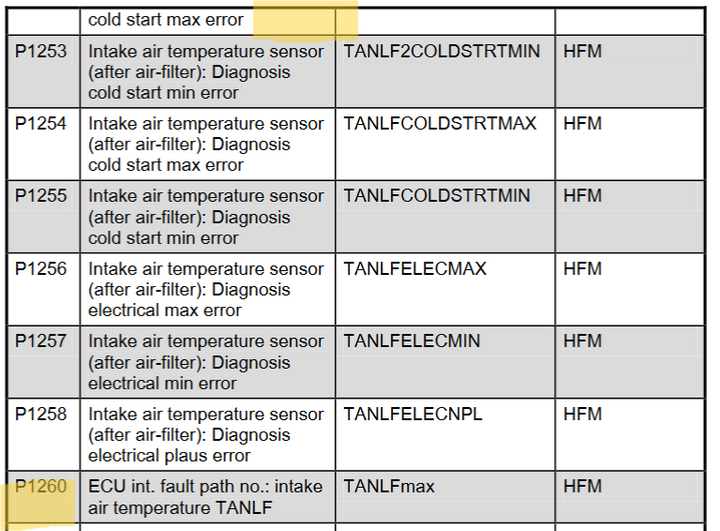
As a hopeful part of the process of elimination I have completely removed both MAFs (HFMs) and cleaned them thoroughly with the correct electronics parts cleaner, but no joy. I've also done the typical checks of fuses, visual inspection of wiring/harnesses/connectors, etc.
Somehow I am off track and I think the mystery might be in the TANLF if I can come up with its meaning.
This is a screenshot of another section within the AM diagnostics which puts more "English" around the TANLF
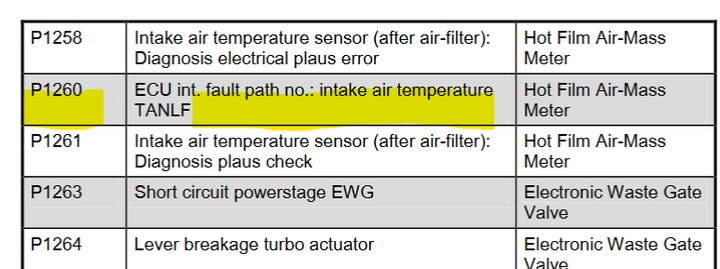
If anyone has some suggestions, they are very welcomed!
I know a few things about this fault:
It is a cold start fault
It is an air stream fault somewhere past the air filters.
The Aston diagnostics information does not distinguish whether this is an air stream fault on the ECU A side (master ECU), or the ECU B side (slave ECU).
I have the Aston diagnostics; however, after spending numerous hours pouring over documents, I cannot, interpret the AM hieroglyphics which further describes the fault. So here in this community, I am asking if anyone can interpret TANLFmax. I know HFM is the hot film air mass meter (MAF)s,. Both MAFs on this platform have an IAT as part of their circuits, again however, the fault tables are not calling out a specific side (master or slave).
Here is the diagnostic table from AM
As a hopeful part of the process of elimination I have completely removed both MAFs (HFMs) and cleaned them thoroughly with the correct electronics parts cleaner, but no joy. I've also done the typical checks of fuses, visual inspection of wiring/harnesses/connectors, etc.
Somehow I am off track and I think the mystery might be in the TANLF if I can come up with its meaning.
This is a screenshot of another section within the AM diagnostics which puts more "English" around the TANLF
If anyone has some suggestions, they are very welcomed!
I’ve got this on my db11, amonsgt others, I’m investigation a cooling system fault on dash. I’ve taken off both airboxes to try and find problem. Only thing I’ve disconnected is MAF’s and this code has popped up. There are a few others relating to the MAF sensor but my topdon scanner isn’t really that good for the V12. Do you have AMDS2 diagnostics? Only people who have it on my side of the pond is Aston themselves. It doesn’t help you much but you could start at MAF sensors and see.
I do not have AMDS, instead, scanning the car using 3rd party info I have on where AM went when they developed this EMS. I use a deep scan tool, which can deep scan about any car on the planet EXCEPT AM, but not stopping me. I know they've used some "platform" from MB and some "platform" from Volvo. My scan tool is an Autel MX808. I can get the scan tool to do a deep scan when fooling it into thinking I am connected to a MB AMG with the 4.0L platform; and, I am working on fooling it into thinking I am scanning a Volvo XC90 platform.
Reguards the engine alone, and power train faults, any scan tool will read P-codes. I am using a $49 (USD) scan tool to bring up the P1260. I am confident that P-code is correct, just chasing it has become frustrating.
BTW - as a regular part of maintenance I've done on any car I've owned, I've renewed the air filters and cleaned the boxes. Everything in front of the two MAFs I am comfortable with, and the MAFs themselves have been cleaned thoroughly. Barring a defective MAF, I should be good to that point of the incoming air stream.
I am about ready to start the pinout diagnostics on the MAFs and the harnesses back to the ECUs. For me, other than replacing the MAFs at $125 USD EACH, I am struggling where else to go.
Of all the cars I've owned, AM is the most difficult, (AND intriguing) simply because the factory holds so closely to the vest, any information or parts access. Because it is so boutique and out of the mainstream, no outside companies waste any time on trying to hack or recreate its EMS....frustrating...but love the challenge just the same.
Reguards the engine alone, and power train faults, any scan tool will read P-codes. I am using a $49 (USD) scan tool to bring up the P1260. I am confident that P-code is correct, just chasing it has become frustrating.
BTW - as a regular part of maintenance I've done on any car I've owned, I've renewed the air filters and cleaned the boxes. Everything in front of the two MAFs I am comfortable with, and the MAFs themselves have been cleaned thoroughly. Barring a defective MAF, I should be good to that point of the incoming air stream.
I am about ready to start the pinout diagnostics on the MAFs and the harnesses back to the ECUs. For me, other than replacing the MAFs at $125 USD EACH, I am struggling where else to go.
Of all the cars I've owned, AM is the most difficult, (AND intriguing) simply because the factory holds so closely to the vest, any information or parts access. Because it is so boutique and out of the mainstream, no outside companies waste any time on trying to hack or recreate its EMS....frustrating...but love the challenge just the same.
Zolliez said:
Did you happen to solve and clear the code? My DB11 V12 just threw the code and a CEL. I unplugged the MAF cables and replugged them and the CEL cleared, but the code is still present. I am considering replacing the MAF meters as the next step.
Hi Zolliez,I still have the problem. The code will set and CEL about every 3 to 5 ignition cycles. Without a permanent solution, so far, I just clear the code (But the P1260 does stay in permanent memory) and drive on until the next time.
Since the dates above I did purchase 2 new MAFs, replaced the old ones, and no joy. I can save you the money purchasing these.
Back to P1260, and by the description I have for this code via the Aston documents, it is a fault related to emissions and drive cycles. The code P1260 stays permanent until all the system's drive cycles are completed. However, the drive cycles never complete because everytime the ECU tests the system "cold start" parameters, the test fails and relights the CEL with a P1260 as the issue preventing the test completion.
I haven't tried much more past the new MAFS, but I am thinking, and trying to decipher the actual AM description, that it might be an IAT (Intake air temperature) sensor. These MAFS are supposed to also be an IAT, as many MAFS are, but some systems such as the AMG V8 and the same used in Aston do have a separate (or additional) IAT sensor. This will probably be my next endeavor.
Sorry for you and I know misery loves company, but maybe in a positive vein, now that I have company, additional resources could come our ways.
That's a bummer! I am seeing the AM service this coming week for other unrelated items, and will ask them about the code - perhaps they can also share some light on it and the meaning of TANLF.
A couple of thoughts, when I unplugged the MAF sensors, it threw a bunch of other codes which cleared, which leads me to believe that if it was a MAF sensor, there would be other codes present. Since you replaced yours without any change, I am wondering if it would be the same for IAT codes - that if there was an issue with the sensor, there would be other codes thrown (such as P0096 through P0099 etc.).
A couple of thoughts, when I unplugged the MAF sensors, it threw a bunch of other codes which cleared, which leads me to believe that if it was a MAF sensor, there would be other codes present. Since you replaced yours without any change, I am wondering if it would be the same for IAT codes - that if there was an issue with the sensor, there would be other codes thrown (such as P0096 through P0099 etc.).
That would be great if you can get any insight from an AM back room!
MAFs sometimes also measure IAT along with intake volume. Others only measure intake volume and use a separate IAT sensor. So, if these MAFs are only measuring volume then the MAF is the wrong place to look for this code. Usually MAFs that include IAT are 5 wire; ours are only 4 wire.
Yes, there are a number of faults that will come up if the MAF is unplugged and engine started. Since the ECU requires the intake volume so that it can fuel properly to a 14.7:1 Stoich for gasoline, if it sees no volume at all, it will default to a fueling table based on RPM and ECT. This fault is usually defined as an implausible value. The other codes will specify opens in the circuitry.
Hope you can maybe bend a techs ear on the P1260. I am getting the impression it is not a rare fault of Astons so they might have dealt with it.
Best,
MAFs sometimes also measure IAT along with intake volume. Others only measure intake volume and use a separate IAT sensor. So, if these MAFs are only measuring volume then the MAF is the wrong place to look for this code. Usually MAFs that include IAT are 5 wire; ours are only 4 wire.
Yes, there are a number of faults that will come up if the MAF is unplugged and engine started. Since the ECU requires the intake volume so that it can fuel properly to a 14.7:1 Stoich for gasoline, if it sees no volume at all, it will default to a fueling table based on RPM and ECT. This fault is usually defined as an implausible value. The other codes will specify opens in the circuitry.
Hope you can maybe bend a techs ear on the P1260. I am getting the impression it is not a rare fault of Astons so they might have dealt with it.
Best,
skhannes said:
Yes, there are a number of faults that will come up if the MAF is unplugged and engine started. Since the ECU requires the intake volume so that it can fuel properly to a 14.7:1 Stoich for gasoline, if it sees no volume at all, it will default to a fueling table based on RPM and ECT. This fault is usually defined as an implausible value. The other codes will specify opens in the circuitry.
Understood and makes sense - thinking out loud about the IAT. If it is truly an IAT issue, then shouldn't one be seeing other codes associated with the IAT, just like one sees with the MAF when it's unplugged - that the IAT is not providing correct values - indicating a failure. I'll try my best with the AM Tech. I'm getting the AMR tune done, so they'll need to plug in to get it done and hopefully they'll share some wisdom!
So AMR flash was done, and during that it cleared out all codes. Unfortunately they do not have any info on what the code could relate to specifically since they flashed it, but I'll be driving it a bit over the next couple weeks and if it comes up again they'll let me know and rescan the car.
Sorry I cant be of more help!
Sorry I cant be of more help!
kabman said:
P1206/TANLFMax relates to the temperature sensor in the MAF on the RH bank (RH as viewed from the driver's seat). A 'max' error usually means an open circuit. Check for continuity between pin3 at the MAF connector and pin103 at the RH ECM.
Thanks for this! I can make these checks maybe over the holidays. I did replace the MAF with new and no joy. I will try to document for this thread and hopefully helps anyone else.Thanks to Mr. Z - I expected, with a tune reflash, it would take P1260 out as the entire contents of the data tables are removed and replaced with a new set in a tune. I've done numerous tunes on other cars in the past but no longer, and this was the case.
Back to the instructions in this quoted reply - I am concluding then that a P3260 would be the LH ECU/ECM?
UPDATE
I took Mr. Kabman's advice. After trying a couple different MAFs and realizing the only options left were opens/shorts and possibly a bad ECM, I proceeded today to the first step which was his suggestion. To validate a good connection between the IAT terminal (pin 3) of the MAF and the ECM connection I had to remove the main connector to the ECM, then do a continuity test from Pin 3 to the ECM connector at the termination of that wire.
The ECM (Master ECM) is located on the right side behind the wheel well liner.
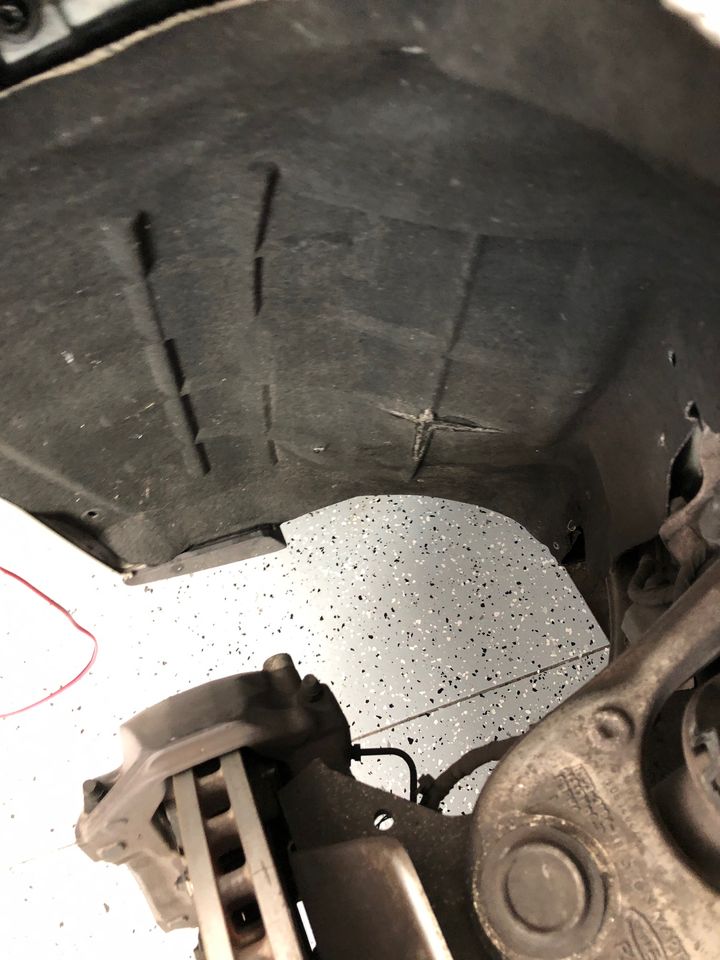
After removing the liner the ECM is exposed. I am disappointed AM chose to put the ECMs in the front wheel liners as environmental conditions are not ideal here. Of the two main harnesses seen at top of the ECM, the connector I need to test is the outside one (connector on the left).
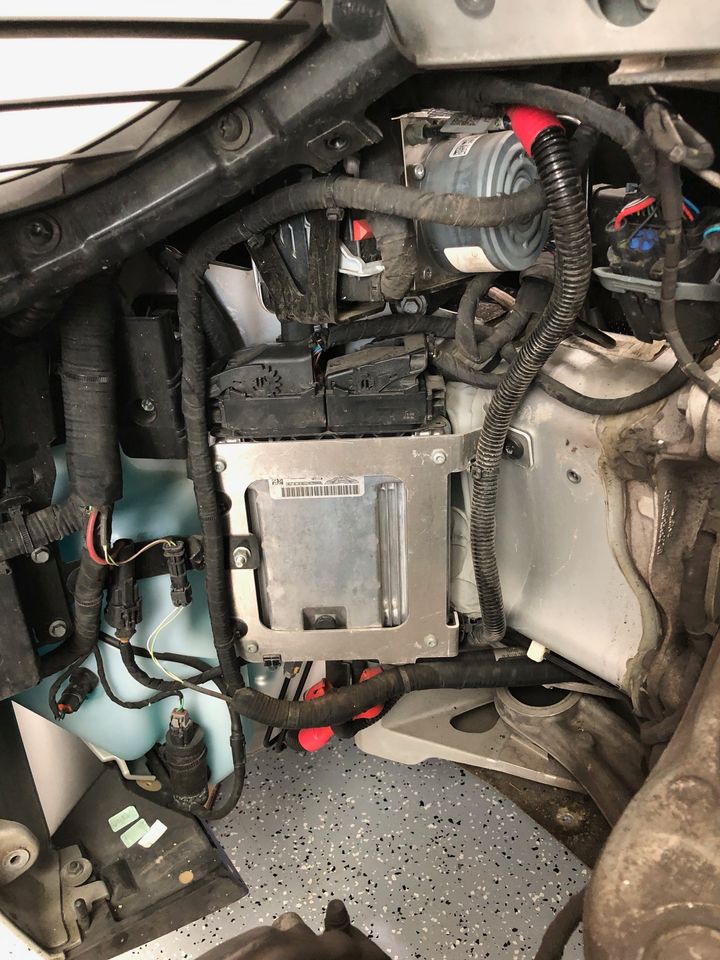
Before disconnecting any harnesses I put the RH side (master) ECM to sleep. This is instead of disconnecting the battery so I could maintain all other electronics live throughout the car. To accomplish this I pulled the 5a fuse in position 1. This is the ECM fuse.
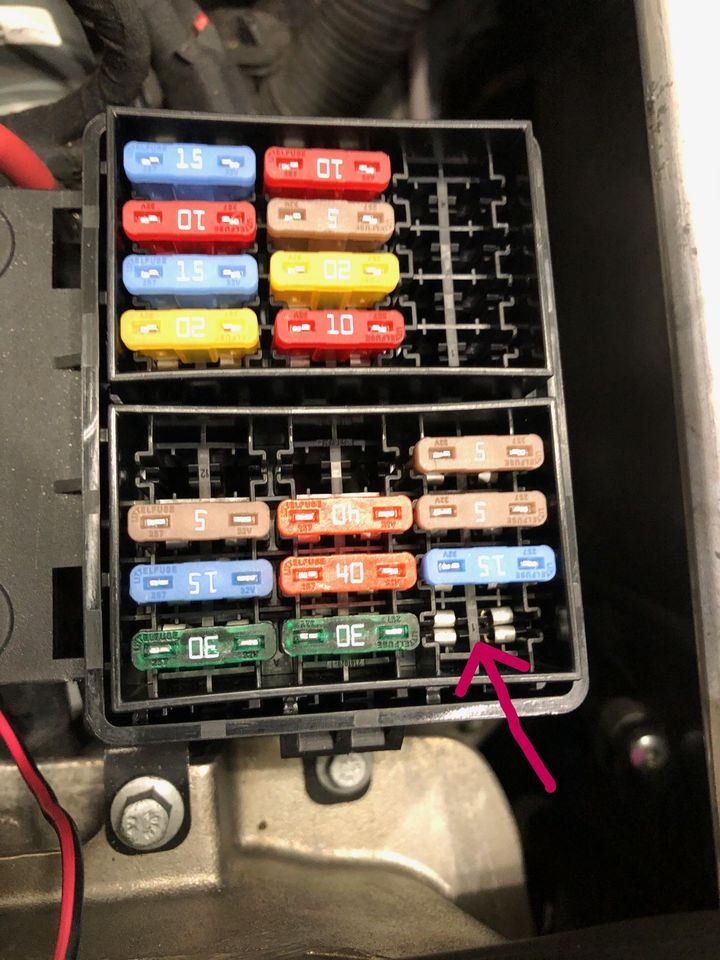
Once the ECM was safe, I proceeded in removing the outside connector:
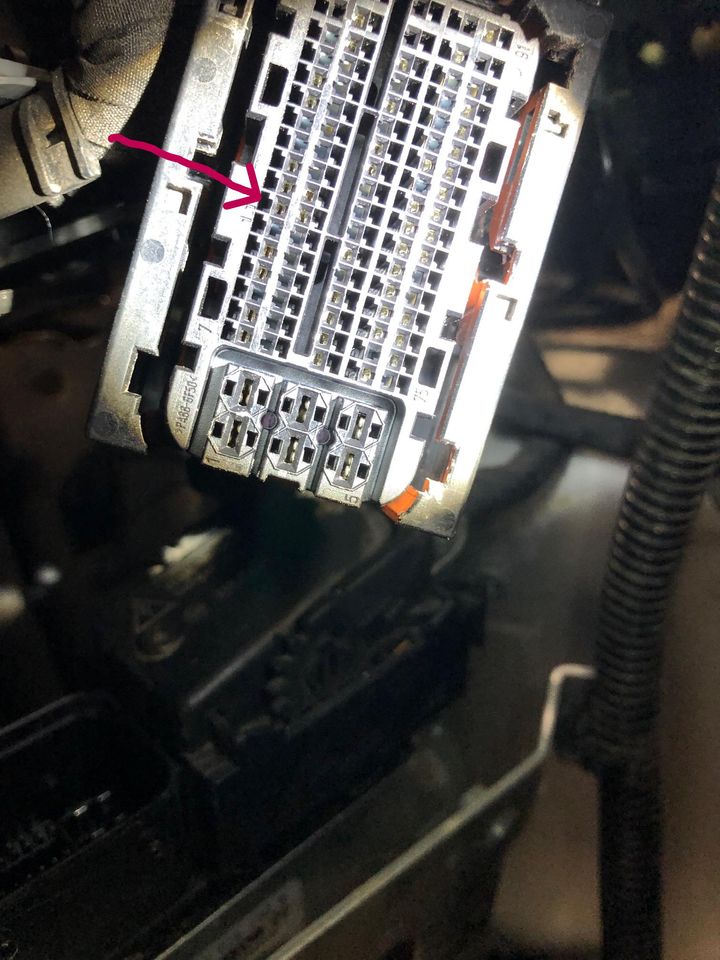
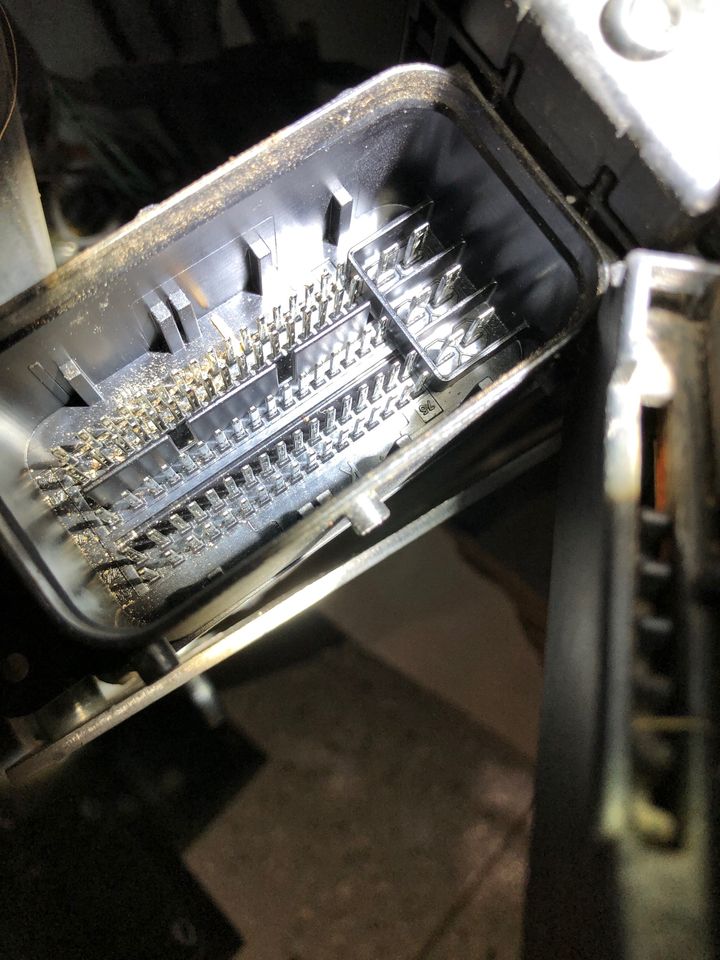
With the connector revealed (pin 13 marked), I reviewed the specs from AM documentation. The pin in the MAF connector is pin #3 as Kabman stated, the pin (other end of the wire) in the ECM connector is pin #13 (I believe Kabman had a typo stating 103).
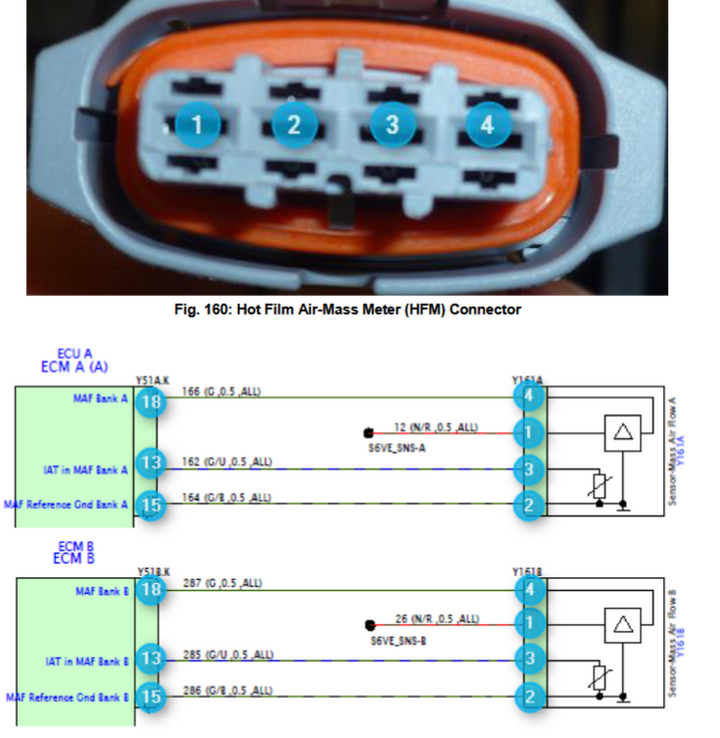
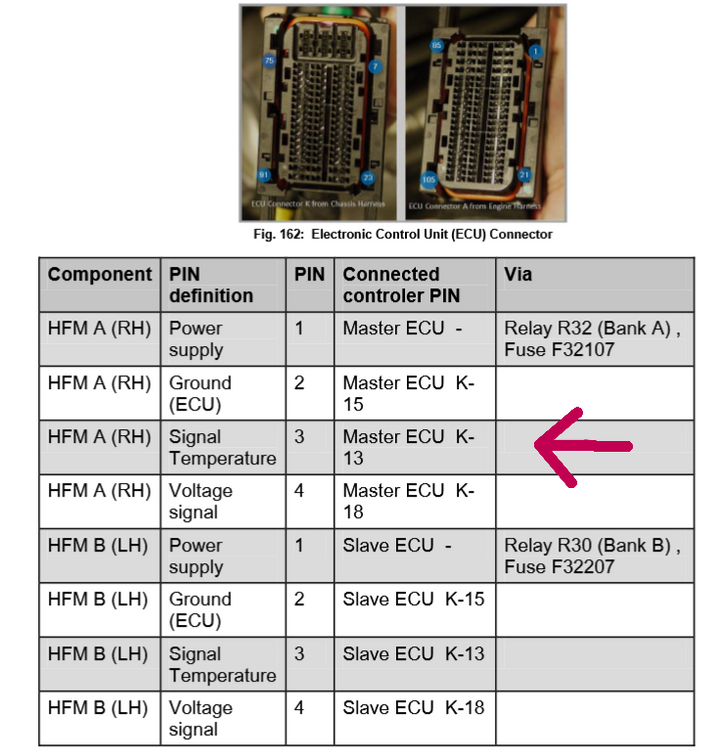
With this I was able to perform a continuity test connecting the two wire ends. This test was successful showing the wire is active at both ends:
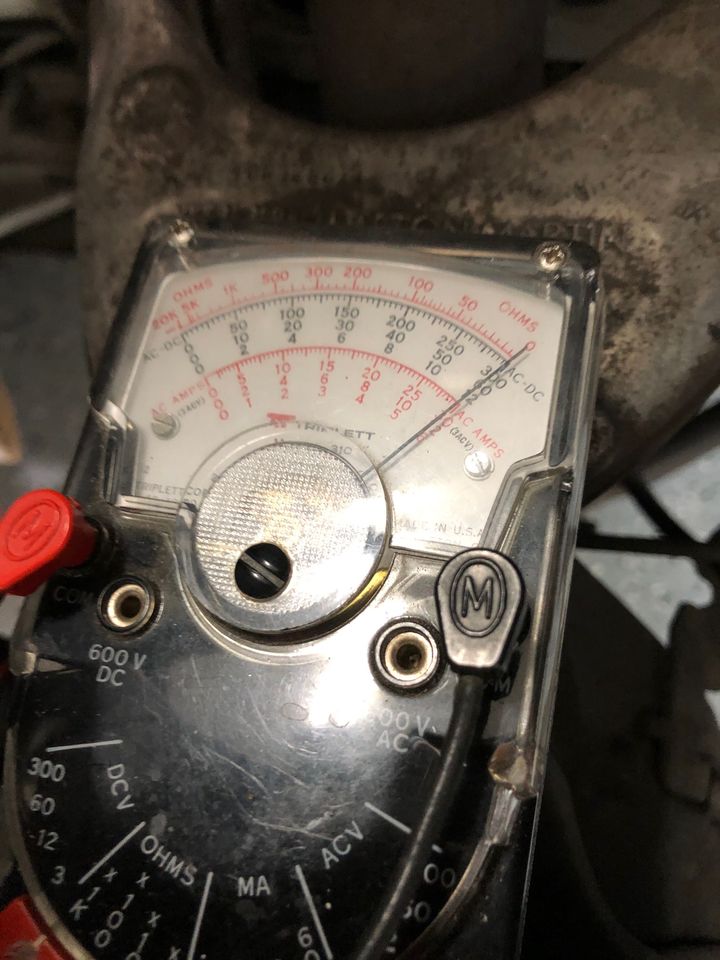
With this in mind, and sure the MAF is good, it leaves two possibilities -
The connection point between connector and pin 13 at the ECM has a high resistance condition (dirty or possible film causing a corrosive condition).
If not that, then a bad ECM
Knowing that and while connectors were off, I used a contact cleaner on both parts, used a blowgun to ensure there was no debris between the connector and the ECM. The contact cleaner I used was CRC QD Electronic contact cleaner.
From this point, I reversed the disassembly, started the car, engine ran fine.
From this writing I now have 5 ignition starts with no P1260 CEL. This is hopeful that the fault all along was a high resistance connection point that I was able to clean up. Before this I have not made it to 5 ignitions w/o seeing another P1260. I know this is still early and I will update this thread to report either that P1260 returned, or that all is now good.
Thanks for the contributions to this thread.
NOTE: This is the contact cleaner I used:

I took Mr. Kabman's advice. After trying a couple different MAFs and realizing the only options left were opens/shorts and possibly a bad ECM, I proceeded today to the first step which was his suggestion. To validate a good connection between the IAT terminal (pin 3) of the MAF and the ECM connection I had to remove the main connector to the ECM, then do a continuity test from Pin 3 to the ECM connector at the termination of that wire.
The ECM (Master ECM) is located on the right side behind the wheel well liner.
After removing the liner the ECM is exposed. I am disappointed AM chose to put the ECMs in the front wheel liners as environmental conditions are not ideal here. Of the two main harnesses seen at top of the ECM, the connector I need to test is the outside one (connector on the left).
Before disconnecting any harnesses I put the RH side (master) ECM to sleep. This is instead of disconnecting the battery so I could maintain all other electronics live throughout the car. To accomplish this I pulled the 5a fuse in position 1. This is the ECM fuse.
Once the ECM was safe, I proceeded in removing the outside connector:
With the connector revealed (pin 13 marked), I reviewed the specs from AM documentation. The pin in the MAF connector is pin #3 as Kabman stated, the pin (other end of the wire) in the ECM connector is pin #13 (I believe Kabman had a typo stating 103).
With this I was able to perform a continuity test connecting the two wire ends. This test was successful showing the wire is active at both ends:
With this in mind, and sure the MAF is good, it leaves two possibilities -
The connection point between connector and pin 13 at the ECM has a high resistance condition (dirty or possible film causing a corrosive condition).
If not that, then a bad ECM
Knowing that and while connectors were off, I used a contact cleaner on both parts, used a blowgun to ensure there was no debris between the connector and the ECM. The contact cleaner I used was CRC QD Electronic contact cleaner.
From this point, I reversed the disassembly, started the car, engine ran fine.
From this writing I now have 5 ignition starts with no P1260 CEL. This is hopeful that the fault all along was a high resistance connection point that I was able to clean up. Before this I have not made it to 5 ignitions w/o seeing another P1260. I know this is still early and I will update this thread to report either that P1260 returned, or that all is now good.
Thanks for the contributions to this thread.
NOTE: This is the contact cleaner I used:
Edited by skhannes on Wednesday 18th December 21:14
Interesting read, thanks for posting..
Came across whilst trying to solve an ‘reduced engine performance’ trigger..
Throwing a P3260 code solenoid or catalyst issue but I suspect strongly it’s more likely the AGM battery after 3.5 years, reads 11.8v after only 10mins shut off.
21 DBS SLV btw.
Came across whilst trying to solve an ‘reduced engine performance’ trigger..
Throwing a P3260 code solenoid or catalyst issue but I suspect strongly it’s more likely the AGM battery after 3.5 years, reads 11.8v after only 10mins shut off.
21 DBS SLV btw.
Edited by Whatever123 on Saturday 21st December 14:26
Whatever123 said:
Interesting read, thanks for posting..
Came across whilst trying to solve an ‘reduced engine performance’ trigger..
Throwing a P3260 code solenoid or catalyst issue but I suspect strongly it’s more likely the AGM battery after 3.5 years, reads 11.8v after only 10mins shut off.
21 DBS SLV btw.
On a 21, I am fairly certain you have the same fault as described herein, except on the LH (slave) ECM. Here is the description from the AM diagnostics section. If you compare, you will see it is the exact same fault as the P1260 shown in one of my above posts. Came across whilst trying to solve an ‘reduced engine performance’ trigger..
Throwing a P3260 code solenoid or catalyst issue but I suspect strongly it’s more likely the AGM battery after 3.5 years, reads 11.8v after only 10mins shut off.
21 DBS SLV btw.
Edited by Whatever123 on Saturday 21st December 14:26
BTW - 11.8v is a "threshold" voltage for many of the modules in the car. Once voltage drops below 11.8, especially with "keep awake" modules in the car, the electrical output integrity begins to suffer and fail startup. Not a defective module, just voltage not high enough to sustain full function on the network.
That’s just after 10 mins, it’s 11.0v in the morning and stop / start has been non existent for a couple of weeks now in ‘C’ mode.
So I’ll start with the battery and go from there because we managed to clear the REP warning today but it appeared again immediately without the engine even running, so doubtful its air intake temps or similar tbh
There’s a few reports out there of failing agm batteries at this age point that have given bogus fault codes, funnily though, I have also had a gearbox warning but disappears again immediately upon selecting gear, like it’s getting false reading, very indicative of a failed battery.
Never gave the failed stop / start a thought as I run in sports + mainly where it’s automatically disabled..
I’ll see and reports back, I assume you checked your battery considering your depth of knowledge
So I’ll start with the battery and go from there because we managed to clear the REP warning today but it appeared again immediately without the engine even running, so doubtful its air intake temps or similar tbh
There’s a few reports out there of failing agm batteries at this age point that have given bogus fault codes, funnily though, I have also had a gearbox warning but disappears again immediately upon selecting gear, like it’s getting false reading, very indicative of a failed battery.
Never gave the failed stop / start a thought as I run in sports + mainly where it’s automatically disabled..
I’ll see and reports back, I assume you checked your battery considering your depth of knowledge

Whatever123 said:
That’s just after 10 mins, it’s 11.0v in the morning and stop / start has been non existent for a couple of weeks now in ‘C’ mode.
So I’ll start with the battery and go from there because we managed to clear the REP warning today but it appeared again immediately without the engine even running, so doubtful its air intake temps or similar tbh
On these codes, such as IAT (P1260/P3260) and several others that have direct impact on emissions, the codes do not actually delete even if you have a scan tool that says it erased codes. Instead, these codes stay in memory and IF the issue has been fixed (as I hope mine is now) the code will stay in memory until the EMS completes all of its drive cycles. In your case, and BC the code remained, it just presented itself again on ignition even though the tool said it erased the codes. So I’ll start with the battery and go from there because we managed to clear the REP warning today but it appeared again immediately without the engine even running, so doubtful its air intake temps or similar tbh
If you want to test this - with your scan tool, delete the P3260, then go back and read codes again w/o shutting off ignition and P3260 should still be there.
On the IAT, and with this fault as Kabman pointed out, in an "open circuit" condition, the ECM is saying it does not see the sensor at all much less actually measuring IAT. So, doesn't matter whether there is air flow passing by the sensor, the ECU is saying - I don't see a signal here with a P3260.
Whatever123 said:
Ok, got it, tah
Is it possible to get a false code if that battery is low?
You can’t effectively clear this code in the way you were able, it just is imidistly present again as soon as it’s been cleared and the software tells you such
‘Able to clear but fault is still present’
You can get failures with a battery that is below 11.8v because with voltage that low, circuits within modules begin to get corrupted, so on startup. when the ECM does its startup diagnostics check, some systems will not report so they will leave latent faults (not CELs), faults that usually produce some dashboard messaging. With the correct diagnostic tools for AM, these type codes are usually U-codes (Networking errors). It will not leave something such as misfires (p-03xx codes) obviously, as this takes the engine running to produce and not related to voltage.Is it possible to get a false code if that battery is low?
You can’t effectively clear this code in the way you were able, it just is imidistly present again as soon as it’s been cleared and the software tells you such
‘Able to clear but fault is still present’
Back to the IAT (P1260/P3260 codes).
When the ignition goes on, the ECM performs numerous diagnostics. It sends check voltages to ensure ALL of the various sensors, etc., are out there and reporting present. If you want to test this, with fob in hand, push the start button twice WITHOUT pressing the brake pedal. You will see the dashboard light up as the engine management system is going through all of its checks.
Now, think about what the definition of a P1260 or P3260 is (which was provided by Kabman - THANKS). This (these) fault is an OPEN. With an open, such as a broken wire (or other reasons), there is NO path to/from the ECM. So EVERY ignition cycle, if the open is permanent and not intermittent, the ECM MUST report a P1260 (or P3260 in your case) because the ECM concludes after a startup diag that no IAT sensor exists. It cannot do anything else. It will keep doing that every ignition cycle until, someday, it sees an IAT sensor.
I am hopeful mine was, in fact, a poor, high resistance connection at pin 13 in the ECU. If I was able to improve that with the connector cleaning, I expect not to see a P1260 setting a CEL again.
Gassing Station | Aston Martin | Top of Page | What's New | My Stuff



